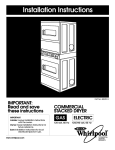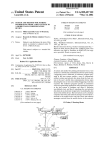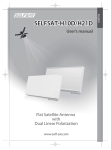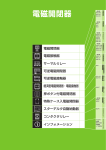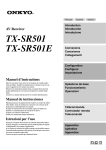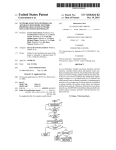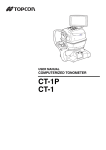Download Apparatus and method for dynamically limiting information sent to a
Transcript
US006477529B1
(12) United States Patent
(10) Patent N0.:
(45) Date of Patent:
Mousseau et al.
(54)
N0v. 5, 2002
APPARATUS AND METHOD FOR
WO
9919988
4/1999
DYNAMICALLY LIMITING INFORMATION
SENT TO A VIEWING DEVICE
W0
W0
9948312
9950974
9/ 1999
10/1999
(75) Inventors: Gary Mousseau, Waterloo (CA); David
Yach, Waterloo (CA); Herb A. Little,
Waterloo (CA)
(73) Assignee: Research In MOtIOIl Limited, Waterloo
(CA)
_
(*)
US 6,477,529 B1
_
Notlce?
_
_
_
SubJeCt to any dlsclalmer, the term of thls
OTHER PUBLICATIONS
Douglas E. Comer, “InternetWorking With TCP/IP”, 1991,
pp. 44—49, 365—385, second edition, vol. I.
Sun Microsystem, User manual for Unix OS, Mar. 2, 1987,
Section; Screen Command, pp, 1—12,
Fifth Nordic Seminar on Digital Mobile Radio Communi
cations,
patent is extended or adjusted under 35
U.S.C. 154(b) by 0 days.
Dec.
1992,
Helsinki,
Finland,
pp.
389—395,
XP458679, Chakraborty ‘Data InterWorking With GSM’.
_
_
* Clted by exathlher
Primary Examiner—Diane D. MiZrahi
(21) Appl- No-t 09/455,211
Assistant Examiner—Apu M Mo?Z
22
( )
Fl (12
16
(74) Attorney, Agent, or Firm—Jones, Day, Reavis &
Pogue; Krishna K. Pathiyal, Esq.; Charles B. Meyer, Esq.
(51)
(52)
Int. Cl.7 .............................................. .. G06F 17/30
US. Cl. ......................................................... .. 707/5
D _ 6 1999
EC ’
Of Search .............................. ..
(57)
ABSTRACT
3, 4, 5,
A System and method for transporting user-restricted data
707/10, 9, 101, 201, 503, 530; 709/203,
217, 219, 225, 226, 227, 229, 234, 247
from a gateway device to a handheld vieWing device is
provided. The gateWay device includes an information
(56)
translator, content ?lters, and storage. The information trans
lator delivers content from an information database coupled
to the gateWay to the handheld vieWing device. A vieWing
component of the handheld device receives all possible data
References Cited
U'S' PATENT DOCUMENTS
5 159 592 A
10/1992 Perkins ..................... .. 370/401
5:327:426 A
7/1994 Donn’ Jr_ et at _
5,355,365 A
10/1994 Ehat et a1. ......... ..
5,559,800 A
370/401
9/1996 Mousseau et a1,
from the gateway device that the hahdhetd device is Capable
of vieWing. The user of the handheld device is then able to
370/401
manually Select Certain Portions of data through a user
370/401
interface. Once the selection is complete, a series of com
6,314,425 B1 * 11/2001 Serbinis et a1. ............. .. 707/10
ments are returned to the gateway device from the handheld
device so that a subsequent vieWing corresponds only to that
FOREIGN PATENT DOCUMENTS
EP
WO
0 483 547 A1
information selected by the user.
5/1992
93/15572
8/1993
33 Claims, 6 Drawing Sheets
[\90
FETCHING STAGE (A)
FRO"
HIRELESS
DEVICE
HOST RECEIVES
INFORMATION SOURCE
FULFILLS THE REQUEST
@
REQUESTS FOR DATA
AND RETURNS THE DATA
\_mo
/\ 90A
Io THE {mm ‘L 102
------------------------ -—RESTRICTING STAGE [B] {PART I 1
I04
I06
GATEWAY RECEIVES
HTML
FULL HTML '"H
FILTER
GRAPHICS. ALL
TAGS AND EMBEDDED
JAVA [0mm
[108
[.HO
I12
114
TIIIEITII
4m
FlIIETERSPTIEFI’TIED
ADVANCED
JAVA
FILTER
FROM STORAGE
HTML
CONIENT
REMOVED
P90‘; To
‘
AREA
TTIRELESS
USER
BYTE-[ODE ntvtct
FILIERED GENERATOR
CONTENT
@
llb
L NB
------------------------- --RESTRICTING STAGE (BI [PART 2)
FROM
WIRELESS
RBEAETEEITVAEYS
DEVICE
PASSED TD
——> COMMANDS AND
CONTENT
@
IDENTFIEIES
2‘ 120
FILTER
SAVE com/mus IN @
[790E
MEMORY/DISK FOR
LATER FILIERING
124
REDUIREMENTS \/_ ‘22
©
@
U.S. Patent
Nov. 5,2002
@mK
Sheet 1 0f 6
US 6,477,529 B1
Z5E:; mBEuP:E 2.5918 2 5m?
9....
i\
mp1
518m
zEZm
25:2825£05“25%;
.)
N
2m:
[email protected] m
U.S. Patent
Nov. 5, 2002
US 6,477,529 B1
Sheet 2 0f 6
5:8:
m
M
£1
m
ma
a‘.@m\
222Ee2_
532%
w
5%
(U:
\I
Em:5%:"?$2515mxom m2522$ 53%2mE8523
\me:12::Qa$3:3:
QH_m.J-ZML~Er.Q_I|\
m2zs5m3wa2z8 "“E5@?$3a:29Sz.5E?38wM55253%
\Emm“[email protected];1%
m222:5e:gW“w82m5E.3z:;
L.:2892m0a5g:;
mE2$5E55eZ5Q1.M2:WE;5ZU
q
J
/
w
E.3;
<2we
2H352m5
1V_)Om
.5
N
U.S. Patent
Nov. 5, 2002
US 6,477,529 B1
Sheet 3 0f 6
2.4
@:Q
.mg
m
u02no
M29$:5.2";:
“Eva
m.\m:2wS2Em:~_5z
N22:+
m <Qm/\‘3ZhE1;PcmH5S2Z5:.o;:m3?1
\:3ME:5£NE2a:853@“H:55ME2l/
:E5QZ2.-
©E5522m:o55%2:J; 28
5
_
8
2
2
:
1
$
Z
6
2
<
5
%
>
2
:
_
5
,
25L8_\5_\:_m2_
aQ$Es.-5:
ma:SE3$3:5;‘E::E:
5@2:15m“:
U82</\52;
s:@52N2:@32:|8\/
zmHowQ¥zm<H%:o\u>w.m=_%f<zw 25E1:E5:
is:QEQ
SE5”8.
US 6,477,529 B1
1
2
APPARATUS AND METHOD FOR
DYNAMICALLY LIMITING INFORMATION
SENT TO A VIEWING DEVICE
proXy is as a TCP/IP “?reWall,” Which is used in most
companies’ netWorks today. This proXy method removes the
TCP/IP protocol from running over the Wireless netWork,
but leaves the actual data transferred untouched. This type of
proXy has limited ability to further limit the higher-level
information being sent to the user, and in particular the
bandWidth heavy graphics and multimedia ?les embedded in
BACKGROUND
1. Field of the Invention
The present invention relates to a system and method that
provide remote control over information sent to a vieWing
device. The system and method provide control over the
content or quantity of information sent to the vieWing
device. In particular, the information may be an Internet or
Intranet World-Wide Web
most Web pages.
10
Still another knoWn method for limiting information sent
to a portable vieWing device is to have users pre-de?ne the
15
vieWing device. In this method, a user must pick, ahead of
time, every site to be accessed and must select the informa
tion to be transferred When connecting With the Wireless
vieWer. This selection is typically done on a large desktop
information sites they intend to access using their portable
page, With Hypertext
Markup Language (HTML), Handheld Device Markup Lan
guage (HDML), Wireless Markup Language (WML), or
computer system, Where visibility, memory, CPU speed and
Java content. The remote vieWing device may be a handheld,
laptop, or palmtop device With a limited vieWing space for
keyboard input are not restricted. The challenge for the user,
hoWever, is to have foreknoWledge of every site to be
the information being received, and preferably connects to
accessed. This method thus falls short of offering the user a
the Internet over a relatively loW-bandWidth Wireless radio
general-purpose broWser for a Wireless device, in Which the
netWork.
2. Description of the Related Art
Typically, handheld or palmtop devices have very limited
vieWing surfaces, limited memory available, sloWer process
ing speeds, and limited user inputs in comparison to large
user maintains dynamic control over What information is
transmitted to the Wireless devices.
SUMMARY OF THE INVENTION
25
desktop computer systems. These devices may also com
municate over a bandWidth-limited data netWork, such as a
provided. The gateWay device includes an information
translator, content ?lters and storage. The information trans
Wireless packet data netWork, a cellular netWork using a
digital packet data protocol, or they may use a limited speed
modem to doWnload at speeds betWeen 9600 and 28K bits
per second (bps). For these reasons it is desirable to limit the
lator delivers content to the gateWay device from an infor
mation database coupled to the gateWay via a netWork. A
vieWing component of the handheld device receives from
the gateWay device all possible data that the handheld device
is capable of vieWing. The user is able to manually select
data these devices receive over the netWork or through the
modem, particularly When receiving large data ?les, such as
Web pages that may include teXt, graphics, animations,
multimedia ?les, or other interactive elements.
A knoWn method for limiting data transfer to such a
A system and method for transporting user-restricted data
from a gateWay device to a handheld vieWing device is
35
certain portions of data through a user interface in the
handheld device, the selected portions corresponding to
information that the user does not Want to vieW during a
vieWing device involves restricting the transmittal of graphic
information. By providing a speci?c con?guration setting
subsequent retrieval of the same data. Once the selection is
available on most Internet broWsers, a user can specify that
complete, a series of command instructions are returned to
the gateWay device from the handheld device so that a
only teXt information is fetched by the broWser. The graphi
subsequent vieWing corresponds only to that information
cal portions of the Web page are left behind. This method is
indiscriminate, hoWever, and leaves the user With little
useful control; simply an on or off sWitch for changing the
type of information vieWed. In many cases there are pieces
of teXt that are not desired in the information stream, and
pieces of graphics that are desired in the information stream,
that Was not selected by the user. Alternatively, the user
could select only that portion of data that the user Wants to
45
but the user has no control over this situation.
vieW during a subsequent doWnload. In this latter situation,
the command instruction transmitted to the gateWay Would
instruct the gateWay to ?lter all information eXcept for the
selected data.
The invention provides control over vieWed content or
information from any database. This control is based on
A second knoWn method, Which is used more commonly
in a Wireless environment, involves neW standards for con
commands stored in the gateWay device. The commands
limit the quantity of information sent to the handheld device.
trolling the content being delivered to the handheld vieWing
device. One such neW standard is HDML, Which Was
This functionality is accomplished by ?rst establishing a set
of information (or content) that is going to be restricted by
intended to replace the universally accepted HTML format
for delivering content to handheld vieWers. This approach
the user. Then, the handheld device performs an editing
has some industry backing, but fails to alloW users access to 55 function to restrict the information received. This editing
all Internet and Intranet information.
process causes a set of commands to be passed back to the
Another knoWn method for solving the Wireless Internet
content problem is to “spoof” the Inter-netWork Protocol
(IP) and Transmission Control Protocol (TCP) so that they
partially Work over the Wireless link. This “spoo?ng”
method, hoWever, often leads to a failure of both the
protocols and the device to display all the information.
Alternatively, several attempts have been made at using a
Wireless proXy to eliminate using both TCP and IP over the
Wireless netWork. A Wireless proXy is a computer that
terminates a TCP/IP connection on one end and a Wireless
connection on the other end. The most common use of a
gateWay device to restrict subsequent or future retrievals of
the same information. The gateWay device identi?es the
subsequent information request and performs the necessary
?ltering in order to restrict the information sent to the
handheld device.
As Will be appreciated, the invention is capable of other
and different embodiments, and its several details are
65
capable of modi?cations in various respects, all Without
departing from the spirit of the invention. Accordingly, the
draWings and description of the preferred embodiment are to
be regarded as illustrative in nature and not restrictive.
US 6,477,529 B1
3
4
BRIEF DESCRIPTION OF THE DRAWINGS
indirectly. To assist the information translator 16 in its task
of getting information and preparing it for transmission to
The present invention Will be apparent to those skilled in
the art in vieW of the accompanying drawings, Where:
FIG. 1 is a block diagram of the components in the
gateWay and handheld device in a preferred embodiment of
the handheld device 22, a content ?lter and storage area 18
is provided, Which is coupled to the information translator
16. The content ?lter and storage area 18 can be located on
the same machine as the information translator 16, in
the present invention;
another location across a local area netWork (LAN), or even
FIG. 2 is a more detailed block diagram of the compo
nents in the gateWay and handheld device of FIG. 1;
FIG. 3 is a How diagram of a dynamic ?ltering process
according to a preferred embodiment of the present inven
10
tion;
the netWork connection 20 and understood by the gateWay
device 14. The information decoder component of the device
FIG. 4 shoWs a graphical user interface (GUI) display on
the handheld device of FIG. 1 during a ?rst and second stage
of the restricting process according to a preferred embodi
ment of the present invention;
15
information restriction commands, as described in more
detail beloW. The presentation component of the device 24
prepares the information for display to the user, and inter
prets special formatting commands Within the data stream
performed by the handheld device according to a preferred
embodiment of the present invention; and
FIG. 6 is a How diagram that illustrates the method
for the information vieWer and user interface 26. The
information vieWer and user interface 26 is directly accessed
by the user, and accepts keystrokes and screen movement
performed by the gateWay device according to a preferred
embodiment of the present invention.
commands during the information request phase and the
25
information reception phase.
A more detailed vieW of the gateWay device 14 and
handheld device 22 is shoWn in FIG. 2. The information
FIG. 1 shoWs a system 10 according to a ?rst embodiment
of the present invention. This system 10 includes a database
or information source 12 coupled to a control device 14. The
translator 16 is coupled to, and communicates With the target
Web site and other information sources database 12‘ through
a Hypertext Transfer Protocol (HTTP) fetch and cache
component 16A. The target Web sites and other information
information source 12 could be an Internet site, an Intranet
site, a database engine, or even a local system. The control
device 14 in the preferred embodiment is a gateWay host
device. The gateWay device 14 includes an information
sources database 12‘ can be a range of computers, computer
systems, and netWorks. For eXample, the information can be
translator 16 and a content ?lter and storage area 18. A
netWork connection 20 couples the gateWay device 14 to a
user interface and vieWing device 22, preferably a Wireless
24 also uses a control channel to the gateWay 14 for
facilitating the eXchange of special requests, such as the
FIG. 5 is a How diagram that illustrates the method
DESCRIPTION OF A PREFERRED
EMBODIMENT
in a node cluster of fault tolerant storage device.
Communication across the netWork connection 20 is
facilitated on the handheld device 22 by the information
decoder and presentation device 24. This device 24 converts
requests from the user into signals that are transmitted across
stored in local databases, on an Intranet, or on the Internet.
35
The information translator 16 further includes a ?lter and
transformation engine 16B, a compression and encryption
handheld vieWing device. The handheld vieWing device 22
support module 16C and a Wireless transport layer 16D. If
the information is not compressed and/or encrypted, then the
includes an information decoder and presentation compo
compression and encryption support module 16C may be
omitted. A Wireless delivery methods module 30 is coupled
to the Wireless transport layer 16D.
nent 24, and an information vieWer and user interface 26.
The netWork 20 is preferably a Wireless packet data netWork,
such as MobiteXTM or DataTACTM, Which has limited band
Width capabilities, although it could be many other types of
As seen in FIG. 2, a Wireless netWork 20‘ couples the
netWorks.
In a preferred embodiment, the handheld device is a
Wireless delivery methods module 30 in the gateWay device
tion may be incorporated into other handheld devices or
14 to a handheld radio code and Wireless support module 32
in the handheld device 22. This handheld radio code and
Wireless support module 32 is coupled to the information
decoder and presentation device 24 through a Wireless
Wireless transceivers, such as tWo-Way paging computers,
transport layer 24A. The information decoder and presen
personal digital assistants (“PDAs”), portable electronic
tation device 24 further includes a compression and encryp
messaging devices, cellular phones, or handheld e-mail
clients. Further, in the preferred embodiment, the gateWay
device 14 and handheld device 22 may be implemented
utiliZing either a softWare-programmable digital signal pro
tion support module 24B and a byte-code interpreter and
decoder 24C. If the information is not compressed and/or
BlackBerryTM or an Inter@ctiveTM Pager manufactured by
Research In Motion Limited. HoWever, the present inven
cessor (DSP) or a programmable logic device.
In this system 10, the information source 12 is a reposi
tory of the information that the user of the handheld device
desires to access for display. An information translator 16,
such as a proXy server, is used as a gateWay to accept a
connection from the netWork 20, and in turn to make a
connection to the information source 12 to retrieve the
45
encrypted, then the compression and encryption support
module 24B may be omitted. An editor and broWser screen
support module 26A in the information vieWer and user
55
interface 26 is coupled to the byte-code interpreter and
decoder 24C. Additional components of the information
vieWer and user interface 26 include a user input and
keyboard support module 26B.
The information translator 16 may include an HTTP fetch
information desired. Preferably, the connection betWeen the
and cache component 16A, Which is standard in the Internet
industry. In other implementations, this machine 16 could
information translator 16 and the information source is a
TCP/IP connection and the information source is a Web
include an Application Programming Interface (API)
method for accessing local database ?les, directory LAN
server containing a plurality of Web pages. As is knoWn in
information and corporate data, or could include other
the art, a proXy accepts a connection from a device and 65 methods of retrieving information. The ?lter and transfor
opens another connection on behalf of the device to alloW
mation engine 16B operatively performs a ?ltering process
the device to communicate With other devices or systems
and information fetch and restrict method, described here
US 6,477,529 B1
5
6
inafter With reference to FIGS. 3 and 5—6. This engine 16B
allows the handheld device 22 to dynamically update a
plurality of information ?lters to match the user’s require
ments for the transmitted information. The compression and
step 106 to form a data stream of ?ltered HTML and Java
content 108. Then, at step 110, any Java commands are
removed to form a data stream of ?ltered HTML information
encryption support module 16C is provided to alloW for
compression and encryption on the data before it is given to
the Wireless transport layer 16D. This compression and
encryption support module 16C may optionally be omitted
from the information translator 16. The Wireless transport
layer 16D is required to deliver the ?ltered (and compressed
and/or encrypted) information to the user. The transport
The restricting stage 90B further comprises the step of
applying a user-speci?c ?lter 114 With ?ltering commands
(C) (see also step 410 in FIG. 6) to further ?lter the data
stream 112. In this step 114, the restricting stage 90B checks
layer 16D also ensures that multiple packets are sent and
received securely Without damage or loss of the information.
The Wireless delivery methods module 30 in the gateWay
device 14 and the corresponding handheld radio code and
Wireless support module 32 in the handheld device 22 (on
112.
10
then it is applied to the ?ltered HTML-only data stream 112
to form a user-?ltered content data stream 116. This data
15
Wants to limit What is vieWed, the second part of restricting
stage 90C occurs. Keeping in mind that no restricting of
information is performed the ?rst time that the data passes
through the system, once the user performs the restricting
steps (208—214 in FIG. 4, and 310—324 in FIG. 5) on the
handheld device, restricting commands (B) are sent to the
gateWay device 14 for identi?cation at step 120. The com
25
or un-restrict content are provided to the ?le storage com
step 114 and applied in the ?rst part of the restricting stage
90B, When the user subsequently requests this information.
device 14. Once this component 24C has processed the
information, the information can be passed up for display
and user interaction in the information vieWer and user
interface 26.
35
screen support module 26A. The editor and broWser screen
support module 26A processes the information so that it is
presentable to the user in a vieWable and readable form. This
component 26A includes a user interface API for screen
FIG. 4 shoWs the sequential graphical user interface
(GUI) vieWs during the process 90. There are tWo stages
shoWn in FIG. 4, a ?rst stage 200A in Which the information
is retrieved, and a second stage 200B, in Which the infor
mation is restricted. During the ?rst stage 200A, the infor
mation is retrieved by the user through the e-mail interface
as shoWn in 202. In this screen, a link to the information is
shoWn in bold Within the conteXt of other information. The
user then selects to folloW the link as shoWn in 204. This
causes a request to be sent to the gateWay device 14. The
manipulation, special formatting, highlighting, inverse
screen 206 is then displayed to indicate a request is pending,
since it could take seconds or minutes to get the information
video, and all other capabilities of the handheld device 22
that might be useful When displaying a large quantity of
information in a readable form. The user input and keyboard
support module 26B is provided for the user to input
commands to manipulate the data or information.
Turning noW to FIG. 3, a ?lter engine process 90 accord
ing to a preferred embodiment of the present invention is set
forth. This process 90 includes a fetching stage 90A, and
mands (C) (see also steps 426 and 428 in FIG. 6) to restrict
ponent 18 at step 122 for long-term storage on a disk and/or
memory 124. These commands (C) are later retrieved during
sion and encryption support component 16C. The byte-code
interpreter and decoder 24C operates to undo all the ?ltering
and encoding preformed on the information by the gateWay
When information arrives at the information vieWer and
user interface 26, it is received by the editor and broWser
stream 116 is then sent to the byte-code converter at step 118
for translation into a format compatible With Wireless deliv
ery.
When a user receives a neW piece of information and
either end of the Wireless connection) provide the protocol
information for the netWork packet formats and delivery
methods of the particular Wireless netWork 20‘.
In the handheld device 22, the Wireless transport layer
24A matches the Wireless transport layer 16D on the gate
Way device 14. Both transport layers 24A and 16D must be
present for end-to-end reliable delivery of information.
When compression and encryption are used, the compres
sion and encryption support module 24B in the handheld
device 22 matches up With the gateWay devices’ compres
the ?lter storage area 124 for a user-de?ned ?lter to apply to
the data stream 112. If such a user-de?ned ?lter is found,
over the netWork.
Once the information has been received, it is displayed in
45 an information broWser-like format 208. At any time the user
can select the menu and pick the “Start Marking” menu item,
as seen in 210, and begin the second stage 200B—the
information restriction stage. During the restriction stage
?rst and second parts of a restricting stage 90B and 90C,
200B, the user positions a moveable cursor across the
information to be restricted, such as line of teXt, or a
respectively. In this process 90, information requests (A)
(see also step 306 in FIG. 5) How into the gateWay device 14
during the fetching stage 90A at step 100. At this stage 90A
particular graphic, as seen in 212. As the cursor is dragged
across the teXt, it changes the appearance of the information
so that the user can visually identify the information selected
the gateWay device 14 is simply acting as a traditional proXy
machine and is taking the request and ?nding the correct
for restriction. Once a delete key, or some other command
55
information source 12 that can ful?ll the request from step
100.
vieW, as seen in 214. The user then continues to scan the
received data to determine Whether other information should
be similarly restricted. Once the user eXits this screen 214,
The requested information is received at the gateWay 14
from the information source 12 and ?oWs into the ?rst part
of the restricting stage 90B at step 104. In this part of the
or selects a menu to close this screen, a series of restriction
commands associated With the restricted information are
sent to the gateWay device 14. These restriction commands
are used by the gateWay to determine Whether or not to
restricting stage 90B, the gateWay device 14 performs gen
eral ?ltering, folloWed by a dynamic restriction step using
the user’s pre-established ?lters. As shoWn in step 104 there
could be HTML content, Java content, pictures, graphics,
animation and other data types received in the data stream
from the information source 12. During this initial restrict
ing stage 90B, advanced HTML commands are stripped at
key is pressed, the information is restricted from the current
subsequently send certain information elements of the
requested information.
65
During the vieWing of the screens 202—214 in FIG. 4, the
basic e-mail presents the Universal Resource Locator (URL)
link as bold faced characters, as seen in 202. When the
US 6,477,529 B1
7
8
cursor is positioned on any character of the URL link the
enter key can be used as a hot key for jumping to the link.
OtherWise, if the user presses a roller Wheel (or some other
ting is complete, the request is transmitted to the gateWay
device 14 at step 306 via the netWork connection 20/20‘.
Some time later, the gateWay device 14 transmits the
information at step 308 to the handheld device 22. The
information is decoded and presented to the user at step 310
selection mechanism) of the handheld device, While on any
URL link, a neW default item appears as seen in 204. In the
case Where the user is positioned on a URL link, the
by the information decoder and presentation component 24.
By using the user interface 26, the user preferably scrolls
through the information searching for undesired sections at
command “FolloW the Link” is the default, as seen in 204.
This is similar to attachment processing When the user is
positioned on an attachment and the “Open Attachment”
menu option is the default. To identify the URL link, the
step 312. The user can enter a scanning termination
10
sequence at step 314, Which is either eXiting the information
e-mail server scans all message bodies and looks for HTTP
or W identi?ers With other special characters such as
user can remove information from the screen at step 316
“//”, “/”, and “.”.
using deletion commands provided by the user interface and
The fetching screen 206 appears When the interface is
invoked from the message vieW, or When the user selects the
“FolloW the Link” menu option in 204. In this case the
program has requested the URL and is Waiting for it to be
returned. If the user is fetching a random URL, then the
program prompts for the URL name before issuing the fetch.
Once information arrives into the broWser, a noti?cation
screen or a menu choice. While vieWing the information, the
15
keyboard 26. Each time a section of data is selected it is
tagged and labeled as having been removed at step 318. A
corresponding restriction command Will subsequently be
sent to the gateWay device 14 (step 324) so that the tagged
information Will be automatically removed from the same
information if a subsequent request occurs.
Once the user has completed an information scan and
tone is played folloWing a user con?gured setting. This
restriction in steps 314—318, the system then determines
setting is different from the message list so the user can
determine if e-mail or Internet traffic has arrived.
In a normal vieWing mode of the message the user is
Whether the user Wants to “un-restrict” some range of
simply moving the cursor across the displayed information
information that Was previously restricted at step 320. If so,
then the information decoder 24 prepares the correct com
25
as if vieWing an e-mail message. Full link names are not
shoWn, only small indicators to make the information more
readable. Invoking the menu 210 provides the option of
marking the information to be restricted in future fetches of
the information. The user can also folloW a link, if the cursor
is on a link, or eXpand or shrink link names for readability.
When in the restricting stage 200B, the restricting com
mands used by the handheld device 22 to ?lter content use
the original section identi?er sent by the information trans
lator 16. In the creation of the original teXt, each section of
the HTML page, either each line or paragraph, is given a tag
35
mand sequence and sends it to the gateWay device 14 at step
322 for execution. OtherWise, the user interface 26 deter
mines if there are any restricting commands present at step
324. If so, then the commands are prepared and sent to the
gateWay device 14 at step 328. If not, then no action is
performed and hence no actions are sent to the gateWay
device 14 at step 326.
FIG. 6 shoWs a preferred method 400 of operation that the
gateWay device 14 performs to enable the user to dynami
cally restrict information sent to the handheld device 22. The
method 400 includes tWo stages: a fetching stage 400A and
a restricting stage 400B. As originally described in FIG. 3,
and shoWn again in FIG. 5, information requests arrive from
or a section identi?er.
When the user is in the “marking mode” 212, the marked
the user at step 402 and are given to the gateWay device 14
region jumps in sections boundaries, as de?ned by the
original section identi?ers sent by the information translator
for processing. Information requests are prepared and given
to the information source at step 404. In the preferred
embodiment, this source is typically a Web site and the
16. In the marking mode, the user marks a section and
TCP/IP protocol is used to transport the information.
After this request for information, the information source
presses the backspace key or ‘ALT’ Backspace key to
remove the information. The user can also press the “Enter”
key to delete the teXt or the backspace key since this is the
default. After the user performs these operations on the
sections to be deleted, including any links, the user can
45
12/12‘ returns the information at step 406 over the Internet
or Intranet to the gateWay device 14 that requested the
information on behalf of the user of the handheld device 22.
Once the information has been received, the gateWay device
select the menu and pick the “Send Restrictions” menu item.
This sends a command With the deleted “sections” to the
information translator 16 for restriction the neXt time this
14 checks to see if there is a user ?lter that matches the
handheld device 22 and information reference number URL
information page is requested. At any time While vieWing the
at step 408. If a match is found, then the user ?lter com
information on the handheld device 22, the user can also
select the “Unrestricted Information” menu item and remove
mands are applied to the information at step 410, Which
any restriction commands that might eXist on the informa
tion translator 16.
FIG. 5 shoWs the preferred method 300 under Which the
handheld device 22 operates to provide the user With the
ability to restrict information received from the gateWay 14.
The method includes tWo stages: an information request
stage 300A and an information restriction stage 300B. The
results in portions of the information being deleted from the
data stream. This information is then sent to the handheld
55
device 22 at step 410, With the selected information
removed. If there are no user ?lters that match the informa
tion being given to this user, the information is sent along as
is to the handheld device 22 at step 412. As shoWn in FIG.
3, other automatic ?ltering operations can also be performed
on the information to remove bandWidth-intensive elements,
such as graphics and animations.
Step 414 in FIG. 6 sets forth the beginning of the
user ?rst decides Whether or not to vieW information at step
302. In the preferred embodiment, this information is
Internet-based or Intranet-based information. The user
restricting stage 400B, in Which the gateWay 14 receives
enters a request, preferably by entering a URL on the user
commands from the user that are used to affect user ?lters.
input and keyboard support module 26B, Which is provided
to the information decoder 24C for preparation and format
ting at step 304 to the gateWay device 14. Once the format
65
The ?rst check in the gateWay device 14 is to determine if
the command is for an unrestriction request at step 416. If so,
then the restriction commands are found and deleted from
US 6,477,529 B1
9
10
5. A system comprising:
storage 18/124 or marked as temporarily inactive at step
418. If not, then the system checks to see if the command is
a content restriction command list at step 420. If it is not,
then the system checks to see if the command is some other
a document server;
a handheld device con?gured to receive a document
transmitted from the document server, the handheld
command at step 422. If the command is a neW content
device being further con?gured to edit selected portions
restriction command list at step 420, then the gateWay device
of the document in response to user input, and to
14 checks to see if there is already a stored set of restriction
commands for this same information page at step 424. If
there is not, then the command information is saved at step
426 in the information storage area 18/124 for later retrieval
generate control signals indicative of the user input;
10
When the user requests the same information page.
OtherWise, a merge of the previous commands and the neW
accordance With the control signals;
Wherein the gateWay device is con?gured to dynamically
15
same information page.
The invention has been described With reference to pre
ferred embodiments. Those skilled in the art Will perceive
restrict the How of information transmitted from the
document server such that user selected portions of the
document are removed in subsequent transmissions of
the document from the document server to the handheld
device.
improvements, changes, and modi?cations. Such
6. The system of claim 5, Wherein the gateWay device
improvements, changes and modi?cations are intended to be
comprises;
covered by the appended claims.
We claim:
1. A method of controlling vieWed information in a
document retrieved from a database based on commands
stored in a gateWay device to limit the quantity of informa
tion sent to a handheld device comprising the steps of:
signals by controlling a How of information transmitted
from the document server to the handheld device in
commands is performed at step 428, and the resulting
merged set of restriction commands are saved in the storage
area 18/124 for later retrieval When the user requests the
and
a gateWay device con?gured to respond to the control
25
an information translator coupled betWeen the document
server and the handheld device; and
a ?lter and memory coupled to the information translator.
7. The system of claim 6, Wherein the information trans
lator comprises:
receiving the document from the database With the hand
restrict subsequent retrievals of the document from the
a Hypertext Transfer Protocol (HTTP) fetch and cache
coupled to the source of information;
a ?lter and transformation engine coupled to the HTTP
fetch and cache; and
a Wireless transport layer coupled betWeen the ?lter and
transformation engine and the handheld device.
8. The system of claim 7, Wherein the information trans
lator further comprises a compression and encryption sup
port module coupled betWeen the ?lter and transformation
database by the handheld device;
engine and the Wireless transport layer.
held device;
establishing information in the document to be restricted
by a user;
using a special editing command With the handheld device
to select the information in the document to be
restricted by the user,
passing a set of commands to the gateWay device to
35
9. The system of claim 6, Wherein the gateWay device
further comprises a Wireless delivery methods component
coupled betWeen the information translator and the handheld
identifying a subsequent retrieval of the document from
the database by the handheld device using the gateWay
device; and
device.
10. The system of claim 5, Wherein the handheld device
performing ?ltering during the subsequent retrieval of the
document in order to remove the restricted information
comprises:
from the document.
2. The method of claim 1, Wherein the database is a
World-Wide-Web
server and the document is a Web
an information decoder and presentation component
45
page.
3. A system for limiting data transmitted to a Wireless
information decoder and presentation component.
11. The system of claim 10, Wherein the information
handheld vieWing device from a gateWay device comprising:
decoder and presentation component comprises:
means for delivering data in a document from an infor
a Wireless transport layer coupled to the gateWay device;
mation database coupled to the gateWay device to the
and
Wireless handheld vieWing device;
a byte-code interpreter and decoder coupled betWeen the
Wireless transport layer and the information vieWer and
means for receiving all possible data in the document
from the gateWay device that the Wireless handheld
vieWing device is capable of displaying;
means for manually selecting eXact portions of data in the
document that are of importance through a user inter
face in the Wireless handheld vieWing device, the
means for selecting being con?gured such that once the
selection is complete a series of instructions are
returned to the gateWay device from the Wireless hand
held vieWing device so that during a subsequent vieW
ing the selected portions of data are removed from the
document.
4. The system of claim 3, Wherein the information data
base is a World-Wide-Web
is a Web page.
server and the document
coupled to the gateWay device; and
an information vieWer and user interface coupled to the
55
user interface.
12. The system of claim 11, Wherein the information
decoder and presentation component further comprises a
compression and encryption support module coupled
betWeen the Wireless transport layer and the byte-code
interpreter and decoder.
13. The system of claim 10, Wherein the information
vieWer and user interface comprises:
an editor and broWser screen support module coupled to
the information decoder and presentation component;
and
a user input and keyboard support module coupled to the
editor and broWser screen support module.
US 6,477,529 B1
11
12
14. The system of claim 10, wherein the handheld device
further comprises a handheld radio code and Wireless sup
port module coupled betWeen the information decoder and
24. A method, comprising the steps of:
fetching a document from a document server;
restricting the fetched document using ?Xed criteria;
restricting the fetched document using dynamic user
de?ned criteria;
presentation component and the gateway device.
15. The system of claim 5, Wherein the document server
is an Internet server.
transmitting the restricted document to a vieWing device;
receiving user input based on the restricted document; and
converting the user input into the user de?ned criteria;
16. The system of claim 5, Wherein the document server
is an Intranet server.
17. The system of claim 5, Wherein the document server
is a World-Wide-Web
server and the document is a 10
18. A system for dynamically ?ltering user-de?ned sec
tions of data, comprising:
criteria comprises the steps of:
a database con?gured to store documents;
receiving commands from a user via a user interface;
a control device con?gured to perform dynamic ?ltering
determining if the command is an unrestricted request;
if the command is an unrestricted request, then deleting or
of a user de?ned section of a document received from
the database; and
a user interface and vieWing device remotely coupled to
the control device, the user interface and vieWing
device being con?gured to convert user input based on
selected portions of the document to ?lter signals and
to transmit the ?lter signals to the control device so that
the control device subsequently ?lters the document
according to the ?lter signals and the interface and
vieWing device subsequently displays the ?ltered data.
marking as temporarily inactive all previous restriction
commands relating to desired information; and
if the command is not an unrestricted request, then
determining if the command is another predetermined
type of command.
26. The method of claim 25, Wherein, if the command is
not an unrestricted request, then performing the steps of:
25
19. The system of claim 18, Wherein the document server
stores textual and graphical data, and Wherein the control
device is con?gured to use the ?lter signals to dynamically
?lter user de?ned sections of the textual and graphical data.
tion command list, then checking for previously stored
commands present for the user and the desired infor
mation; and
if the predetermined type of command is not a content
restriction command list, then checking for other com
the user interface and vieWing device is a Wireless hand
held vieWing device; and
mands from the user.
27. The method of claim 24, Wherein the document server
the document is an Internet Web page.
is a World-Wide-Web
21. The system of claim 18, Wherein the database is a
28. A system for controlling the transmission of informa
tion to a Wireless device, comprising:
22. A method, comprising the steps of:
a World-Wide Web
requesting a document through a Wireless device coupled
server With a plurality of Web
pages; and
a gateWay device con?gured to receive an information
to a host device;
receiving the requested document at the host device from
request from the Wireless device identifying the WWW
a document server;
server and to establish a connection to the WWW
?ltering the received document using a predetermined set
of ?lters;
?ltering the received document using a dynamic ?lter
45
a fetch and cache component that retrieves and stores
information from a Web page on the WWW server;
device from the Wireless device;
transmitting the ?ltered document from the host device to
the Wireless device;
displaying the ?ltered document on the Wireless device;
storing user input based on the displayed document;
converting the stored user input into the user-de?ned ?lter
criteria;
a restricting stage that removes at least one predeter
mined data type from the information retrieved from
the Web page to generate a ?ltered output;
means for transmitting the ?ltered output to the Wire
less device;
55
transmitting the user-de?ned ?lter criteria to the host
device; and
the dynamic ?lter;
Wireless device in response to user input made by
selecting a portion of the Web page to be removed in
Wherein the user-de?ned criteria is based on a selected
portion of the document and Wherein subsequent
requests for the document through the Wireless device
subsequent transmissions from the gateWay device.
29. The system of claim 28, Wherein the gateWay device
are ?ltered to remove the selected portion of the
server and the document is a
an additional restricting stage that receives a ?ltering
command from the Wireless device and that uses the
?ltering command to remove additional data from
the information retrieved from the Web page and
generate the ?ltered output; and
Wherein the ?ltering command is generated by the
storing the user-de?ned criteria at the host device to de?ne
document.
23. The method of claim 22, Wherein the document server
server over a computer netWork, Wherein the gateWay
device comprises:
based on user-de?ned criteria transmitted to the host
Web page.
server and the document is a
Web page.
server and the document is a Web
page.
is a World-Wide-Web
determining Whether the predetermined type of command
is a content restriction command list;
if the predetermined type of command is a content restric
20. The system of claim 19, Wherein:
the control device is a gateWay device;
World-Wide-Web
Wherein the user de?ned criteria is based on a selected
portion of the document.
25. The method of claim 24, Wherein the step of restrict
ing the fetched information using dynamic user de?ned
Web page.
further comprises:
65
a compression and encryption module that compresses
and encrypts the ?ltered output prior to transmission to
the Wireless device.
US 6,477,529 B1
13
30. The system of claim 28, wherein the pre-determined
data type is advanced HTML commands.
31. The system of claim 28, Wherein the pre-determined
data type is Java content.
14
33. The system of claim 28, Wherein the transmitting
means includes a Wireless delivery module that adds proto
col information for delivery over a Wireless netWork.
32. The system of claim 28, Wherein the transmitting 5
means includes a Wireless transport layer.
*
*
*
*
*














